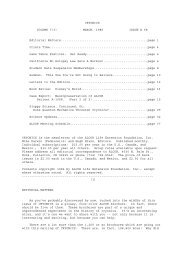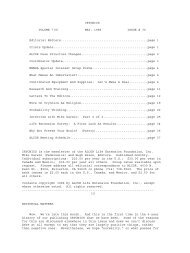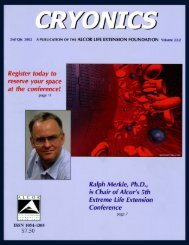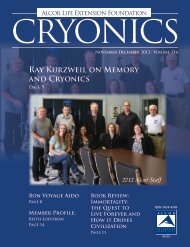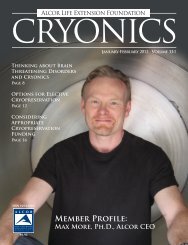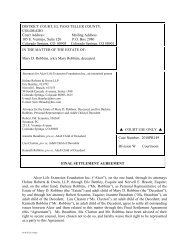CURTIS HENDERSON - Alcor Life Extension Foundation
CURTIS HENDERSON - Alcor Life Extension Foundation
CURTIS HENDERSON - Alcor Life Extension Foundation
- No tags were found...
Create successful ePaper yourself
Turn your PDF publications into a flip-book with our unique Google optimized e-Paper software.
MP:CH:MP:CH:great with writing and organizingthings, and the three of us just fittogether.What action did you take?We started the Cryonics Society ofNew York because nobody was happywith the <strong>Life</strong> <strong>Extension</strong> Society for awhole bunch of reasons. BeforehandSaul and me had taken a trip across thecountry and visited all of the peoplewho had been interested in life extension—withEv Cooper, with all thepeople who claimed they had facilitiesto freeze people. With the exceptionof Ed Hope in Arizona they all turnedout to be total fabrications, nothing.The end of that trip was coming backthrough Michigan and having ahearing with Ettinger, whose grouphad become the Cryonics Society ofMichigan [as it eventually was called].Tell me more about forming your owngroup, the Cryonics Society of NewYork.After we got back from the trip, wehad to file papers in Albany to get anon-profit corporate certificate, andstatus, and start working on a tax-freestatus, so we had to come up with aname. Karl Werner and I were in theFrank Charles Bar one night and madethe name “cryonics” up out of theblue. I don’t know whether he suggestedit or I suggested it but it justclicked. Saul wanted to get thisnewsletter out and he needed a nametoo. I remember meeting at the FrankCharles Bar mostly because I had a jobin the city, I lived out in Sayville and Iused the Long Island Railroad once aweek to go back and forth once aweek. I had to change trains inJamaica, and the Frank Charles Bar isonly about two blocks from the railroadstation. So we formed theCryonics Society of New York, but wenever dreamed we’d have anything todo with physically freezing bodies.Our idea was for more or less a discussionclub. It was totally in the realm ofMP:CH:speculation. Our first real act was Saulputting out the newsletter.What problems did you encounterwhen you decided to go beyond merespeculation and really do cryonics?We found out that no big companywas going to make storage tanks, andno medical people were really interestedin the idea. We seemed to be theonly ones interested, in fact. We hadno idea of the complications or thecost. I think Ettinger’s first figureswere in the neighborhood of $5,000to freeze and store somebody indefinitely.Ettinger was always talkingabout freezing the first man. Whenthey froze the first man all sorts ofmagical things were going to happen.The world would see that you wereright (I had doubts about that) but hewas so adamant in his concept offreezing the first man. He would havethese people contact him but hewould never go through with it. Therewere several people he was going tofreeze when they died but for somereason—we never got the details onit—they weren’t frozen. Since then Irealized that when it came to push andshove and you actually had to dealwith morticians and doctors and soon, he was quickly discouraged.Robert Nelson was impressed with uswhen, on our trip, we visited him inCalifornia, because we were from outof state and had some very goodlookingbrochures for the time, andwere putting out a newsletter. Hethought we were the big hotshotsfrom New York with a big Buick andplenty of money. As I said, though,the people we saw were mostly justindividuals with a passing interest incryonics. The only one who wasmaking any kind of a tank was Hopein Arizona. At the time I knewnothing about cryogenic tanks—infact, that’s where I learned aboutthem. We spent a couple of weeksliving and sleeping there at Hope’sfacility. It was just a warehouse, just anMP:CH:industrial bay. At that time he had atank with a woman in it, and it washolding liquid nitrogen though notwell—he had to keep the vacuumpumps going. He was making othertanks. He had hired a couple of engineers,and he was spending quite a bitof money, more than everyone elseput together, on developing some sortof tank that would work. After that wecame home, and it was several weeksafter that that Nelson froze Bedford.Tell about your early experiences actuallyfreezing people.First of all we realized that you had tohave the cooperation of a mortician,because you had to get into thelicensing system of handling a deadbody. You couldn’t just pop up andsay, “hey, we’re a cryonics society,somebody just died, now give us thebody,”—they won’t do that. So wewrote letters to every funeral directorlisted on Long Island and we got noanswer. One man however, Fred Hornat St. James, called us and he said hewas interested. We gave him what literaturewe had, and because he’dbroken his leg skiing he took the timeto read it. That’s literally the truth—headmitted it many times. He neverwould have read any of it if he hadn’tbeen sitting there with his leg in a cast.But he became interested in it, andwhen Steven Mandel died he more orless put all of us on the spot: Now,this was it, either put up or shut up. Atthat moment we had somebody whohad made the preparations, who’dsigned papers indicating he wanted tobe frozen, and had an insurance policythat had been signed over to hismother with the proviso that it wasgoing to be used to freeze him. Hismother called us when he died, sonow it was put up or shut up time.We’re gonna do it or not. And we didit. And of course from then on itceased to be a discussion group.From the pressures of keeping himfrozen and Mrs. Deblasio and thewww.alcor.org Cryonics/Third Quarter 20099



